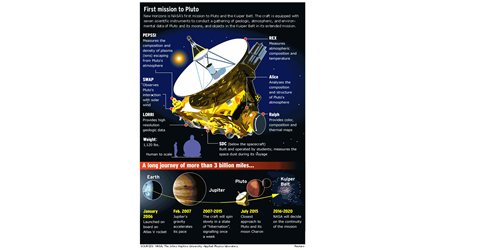Close encounter with distant Pluto getting under way

NASA’s New Horizons spacecraft is closing in on Pluto and its five moons. Soon we will see what no one has ever seen before: Crisp, clear pictures of the tiny, icy world.
“The pictures are what we’re all waiting for,” Alan Stern, New Horizons principal investigator, told CNN.
Up until now, the best images of Pluto have been a few pixels shot by the Hubble Space Telescope. The images, released in 2010, took four years and 20 computers operating continuously and simultaneously to produce, according to Marc Buie of the Southwest Research Institute in Boulder, Colorado.
They show what NASA called an “icy and dark molasses-colored, mottled world that is undergoing seasonal changes in its surface color and brightness.”
That’s not a very glamorous description, but NASA said the images confirmed Pluto is a “dynamic world that undergoes dramatic atmospheric changes, not simply a ball of ice and rock.”
New Horizons is aiming its Long-Range Reconnaissance Imager (LORRI) telescope at Pluto to help navigate the final 135 million miles (220 kilometers) of its 3 billion mile journey. Besides LORRI, the space probe is packed with cameras and other instruments. By mid-May, we should get “better than Hubble” photos. We’ll also see Pluto’s five moons: Charon, Nix, Hydra, Kerberos and Styx.
Stern expects new “optical navigation images” to arrive any day now.
“I think of Pluto as a kind of a Christmas present that’s been sitting under the tree” waiting to be unwrapped, Stern said. “I just can’t wait to see what’s there.”
New Horizons was launched on January 19, 2006. It will arrive at Pluto on July 14, 2015. The probe is 27 inches (0.7 meters) tall, 83 inches (2.1 meters) long and 108 inches (2.7 meters) wide. It weighed 1,054 pounds (478 kilograms) at launch.
New Horizons was launched before the big debate started over whether it’s a planet. For the scientists on the New Horizons team, Pluto is very much a planet — just a new kind of planet.
“New Horizons is on a journey to a new class of planets we’ve never seen, in a place we’ve never been before,” says New Horizons Project Scientist Hal Weaver of APL. “For decades, we thought Pluto was this odd little body on the planetary outskirts; now we know it’s really a gateway to an entire region of new worlds in the Kuiper Belt, and New Horizons is going to provide the first close-up look at them.”
Some interesting tidbits about Pluto:
— Pluto is classified by NASA as a dwarf planet.
— It has five known moons: Charon, Nix, Hydra, Kerberos and Styx.
— Pluto is about two-thirds the diameter of Earth’s moon.
— It probably has a rocky core surrounded by ice.
— It’s one of a group of objects that orbit beyond Neptune in the Kuiper Belt.
— Pluto is about 20 times as massive than Ceres, the dwarf planet between Mars and Jupiter that will be explored by the Dawn spacecraft on March 6, 2015.
— Pluto has a 248-year-long elliptical orbit around the sun.
— From 1979 to 1999, Pluto was actually closer to the sun than Neptune.
— Pluto was discovered in 1930 by Clyde Tombaugh at the Lowell Observatoryin Flagstaff, Arizona.
— It was named by 11-year-old Venetia Burney of Oxford, England.
Source: CNN





